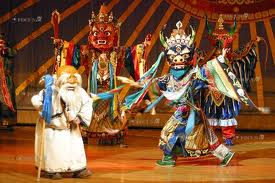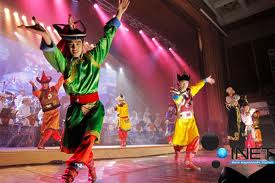MONGOLIAN CULTURE
The culture and society of Mongolia is greatly influenced by the central role of nomads which is still the way of life for half of Mongolia's population of 2.8 million people. Mongolia is one of the last nations in the world today that has such a high proportion of nomadic citizens. The extreme climatic conditions of Mongolia bring enormous fluctuations of weather with very hot, parched summers and winters with temperatures of minus 35 degrees. The sustained severe cold causes massive loss of livestock herds almost every year. This very difficult environment requires great strength and deep reserves of will to survive and thrive in. Mongolian people have lived and thrived in this unforgiving environment for many hundreds of years and have a deep enduring fondness for their homeland. Mongolian music conveys this deep appreciation that Mongolians have for their country, its natural beauty and the inspiring deep blue sky above the vast Mongolian landscape. Mongolian songs are often about beloved horses and the beauty of the Mongolian countryside. Herders sing while riding their horses and most Mongolians are expected to know at least one song to be shared with others on special occasions or just to lighten the heart.
Khoomi
Singing which also known as Throat Singing, allows the singer to produce harmonic tones that can mirror the sounds of waterfalls, the steppe winds blowing, and the chants of Buddhist monks. Khoomi singers use their diaphragms like a bellows on a bagpipe to emit a steady bass note while simultaneously producing a higher nasal tone and essentially carrying two tunes at the same time.
The traditional Long Song
The traditional Long Song is the great Mongolian classical form of singing and is a powerful way of musically expressing deep emotions for loved ones, the land, nature and beloved horses. Ms. Namjilyn Norovbanzad is considered the greatest Mongolian Long Song singer of the 20th century. Her powerful voice can fill a music hall without any need for amplification even though she is nearly seventy years old. The song titles from her most recent CD, "The Sun Over the Placid World" convey the typical subjects addressed in the Mongolian Long Song tradition. They include, "The Gently Fluttering Wind", "A Graceful Black Horse", "The Sight of the River Herlen", "A Little Bay Steed", "A Cowboy", and "Misty Crest of a Mountain Ridge".
Morin Khuur (Horse Head Fiddle)
One of Mongolian musical instruments the Morin Khuur has the most prominent place in Mongolian musical forms. Legend has it that a long time ago when the beloved horse of a young Mongolian died, he made a musical instrument from its hair and hide to remind him of his dear friend. The Morin Khuur can produce the rich varied tones of a cello or be coaxed to sound like a horse neighing and galloping.
National wrestling
Traditional Mongolian wrestling called Bukh is the most prominent sport amongst Mongols and is one of the three arenas of competition in the greatest of the annual Mongolian national celebrations called the Naadam. Archery and horseracing are the two other competition sports in the Naadam but the champion wrestlers win the greatest glory. Mongolians prize the strength, skill and dignified character that are the hallmark of great wrestler champions.
Mongolians hospitality is legendary and is a very important part of Mongolian society and culture. Travellers are welcomed in the round nomadic home as called Gers to share cheese, yogurt, and Airag which is fermented mares milk and cherished also by Mongolian city dwellers. Strangers are made to feel welcome almost anytime and in a place where temperature routinely drop to 20 and 30 degrees below zero in the winter months, the warmth of a welcoming Ger is deeply appreciated by the tired traveller. Neighbours are an important ally and mainstay for the Mongolian nomads as they pursue their difficult way of life. Cooperation, courtesy and considerate behaviour towards others are a very important part of Mongolian society and culture.










